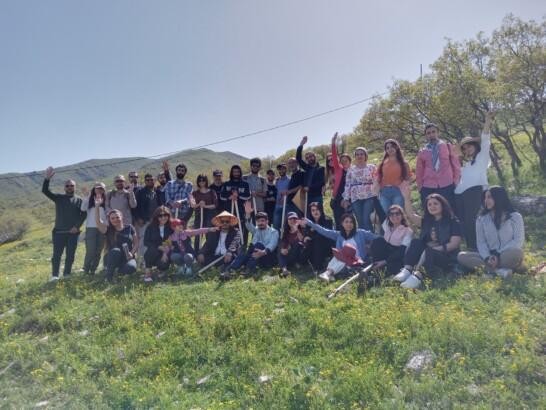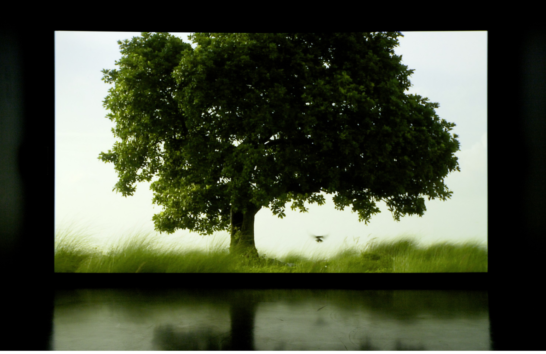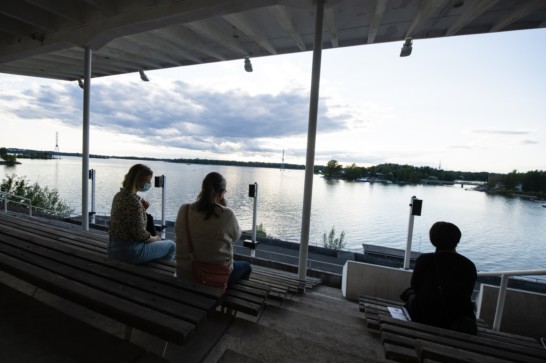Curator’s texts Essay
Curator´s Essay: To Burn, Forest, Fire

A small exercise in sustainability – breathe in and smell
Katie Paterson, To Burn, Forest, Fire 2.9–1.10.2021
There are two green incense sticks on the table in the vaulted space, one of them lit. The words First forest are printed on the side of the narrow stem. In his welcome speech, the audience worker encourages the public to approach the incense sticks and its scent during the ceremony. Many get up from their chairs and take turns at studying the incense from a polite distance, scooping the smoke rising slowly from the incense towards their faces like water. Most people close their eyes so their sense of smell will seize the space from the other senses. The delicate coils of smoke react sensitively to the airflow created by human movements. They escape as far as the ranks of people sitting furthest away. The scent moves around the space like a ghost. It is lifeless, but at times visible, moving, and present. I sit and wait for the scent to reach me. Next to burn is the Last Forest.
Incense ceremonies for Scottish artist Katie Paterson’s To Burn, Forest, Fire were held around Helsinki in September 2021. The first incense seeks to recreate the smell of the first forest on our planet 385 million years ago in what is now New York State, and the second that of the forest in Ecuador right now amid the climate crisis. The forests and scents here have been defined together with an international team of researchers. The work reflects the artist’s burning desire to raise awareness of the sixth extinction, our vital relationship with trees, and to encourage people to take action. The scents of a forest that is in the past and of one that is still alive remind us of the history of forests, which is older than humankind, of their invaluable importance to the human species in the midst of an environmental crisis, of their vulnerability and destruction.
In addition to the environmental crisis, the design and execution of Paterson’s artwork has been marked by the coronavirus pandemic. During the pandemic, breathing and smelling have become risky activities: we can catch a disease whose effects on our bodies are not yet fully known. Outside our homes we breathe through protective masks and scents do not reach us. This is why at the end of the series of ceremonies, we also distributed incense packs to the public for home ceremonies. Once inside our body, the molecules become an olfactory experience in the part of our brain where memory, emotions and sense of time are located. Thus, scents often evoke memories and emotions. Many who attended the ceremony said the first scent of the forest took them back to their childhood nature experiences in forests. Perhaps because in that ancient forest plants familiar to Finns, relatives of today’s fern and Equisetaceae, grew in the moist, swamp-like terrain of the past.
In order to smell you have to breathe: a strong inhalation – and the smell intensifies. When you breathe in, you draw oxygen from trees and other plants into your lungs, and when you exhale you in turn release the carbon dioxide that the plants need. This life-sustaining dependency has become even more important as our atmosphere becomes so filled with carbon dioxide and other greenhouse gases as a result of anthropogenic activity that they warm our climate faster than animals and plants can adapt to them. It remains to be seen by future generations whether the human species will have time to adapt quickly enough. Even if all the CO2 emissions were stopped today, we would still have to actively remove CO2 from the atmosphere in order to be able to curb global warming and avoid reaching critical tipping points and irreversible change.
The title of Katie Paterson’s To Burn, Forest, Fire is a direct translation of the Japanese kanji sign for incense. Incense has been used for millennia in many cultures around the world, most often as part of prayers, sacrifices, and rituals to transport those who experience them above everyday life. Fire is needed to light the incense, the aromatic substances of plant origin are released when the incense burns and the combustion gives off smoke, i.e. the smell of the incense is carried into our bodies as smoke. Fire, the burning of (wood) and the smell of smoke have lent wings to human history for tens of thousands of years. According to Professor David Haskell, who was also involved in the background work for Paterson’s piece, it can be said that it is burning wood that made people human. For millennia, people have gathered around fires to cook, seek refuge, and tell stories. Imagination, past and future, come to life with the burning wood in traditional and new stories. In an era of environmental crisis, the smell of burning wood tells us about the state of emergency all around our planet: burning forests and land, burning homes and habitats, drought and uncertainty.
In his book The Great Derangement – Climate Change and the Unthinkable (2016), the Indian author Amitav Ghosh considers our inability to understand the scale and violence of the climate crisis from a literary, historical and political perspective. According to him, politics and literature have become the individual’s moral reflection rather than collective action. Ghosh says the climate crisis is also a crisis of culture, and therefore a crisis of the imagination. All social action should make it easier to understand the climate crisis and what the transition to sustainability means specifically from the collective viewpoint. He sees imagination and storytelling as the way forward.
A work of art whose main element is fragrance is risky, because experiences of smell and the associations and memories that they evoke are highly individual. People’s ability to use their senses is also individual: for one person the sense of sight is most important, another is sensitive to touch, and a third needs aids in order to hear. For this reason, the small printed leaflet accompanying the work will help ceremony participants tune into the silent forest of the Devonian period and from there to that cornucopia of scents, the Amazon rainforest. Where our senses lead, our imagination follows.
After settling into a relaxed state, accompanied by the soothing scent of the first forest, I suddenly wake up to the fact that the smell of the second incense is reaching me. The last forest. A fresh fruity, vibrant, energizing scent. I feel lucky that the scent found me. I study the leaflet and find the bit where Professor Haskell describes the fragrance experience in the Amazon rainforest in Ecuador:
“To walk in the (rain) forest is to move through thousands of different smells, an immersion in the world’s most diverse collection of fragrances. To discern some of the most noticeable scents scientists and local guides shared their insights and experience: armadillos smell of rotted leaves, while peccaries smell of salty, concentrated chicken broth. The garlic vine has a sweet medicinal smell, contrasting with the alcoholic fizz of fermenting fruits from guava and other trees. The soil and leaf litter are variegated, smelling of fresh peanuts in some places, cloves, pepper, or mould in others. Algae coat every twig and leaf, raising a briny, chlorophyllic haze.”
The destruction of the Amazon rainforest is compounding the climate crisis, biodiversity loss and the human rights crisis. Amitav Ghosh says in a recent article that the killing of indigenous peoples and the pillaging of the land that they have tended for centuries laid the groundwork for the climate crisis. Ghosh sums it up: “(…) for two centuries, European colonists tore across the world, viewing nature and land as something inert to be conquered and consumed without limits and the indigenous people as savages whose knowledge of nature was worthless and who needed to be erased. It was this settler colonial worldview – of just accumulate, accumulate, accumulate, consume, consume, consume – that has got us where we are now.”
During these overlapping, intertwined crises that threaten our very existence, we felt it was important to rely on the power of a delicate, but multi-layered scent. On a work of art that is extremely minimalist in terms of material, requiring only a small quantity of natural resources and leaving only a couple of cubic centimetres of ash. The demand this artwork makes, that we slow down and surrender to our sense of smell, is a small-scale exercise on our journey towards a broader breakthrough in the sustainability revolution. We need to learn to let go of some ways of experiencing the world and to reinforce other ways of thinking and acting that we so far have neither known nor appreciated so well.
Paula Toppila
Curator of IHME Helsinki Commission 2021, Executive Director of IHME Helsinki.
Please, visit our Youtube channel and listen to the conversations between artist Katie Paterson and scientists. They have also inspired the writing of this essay:


